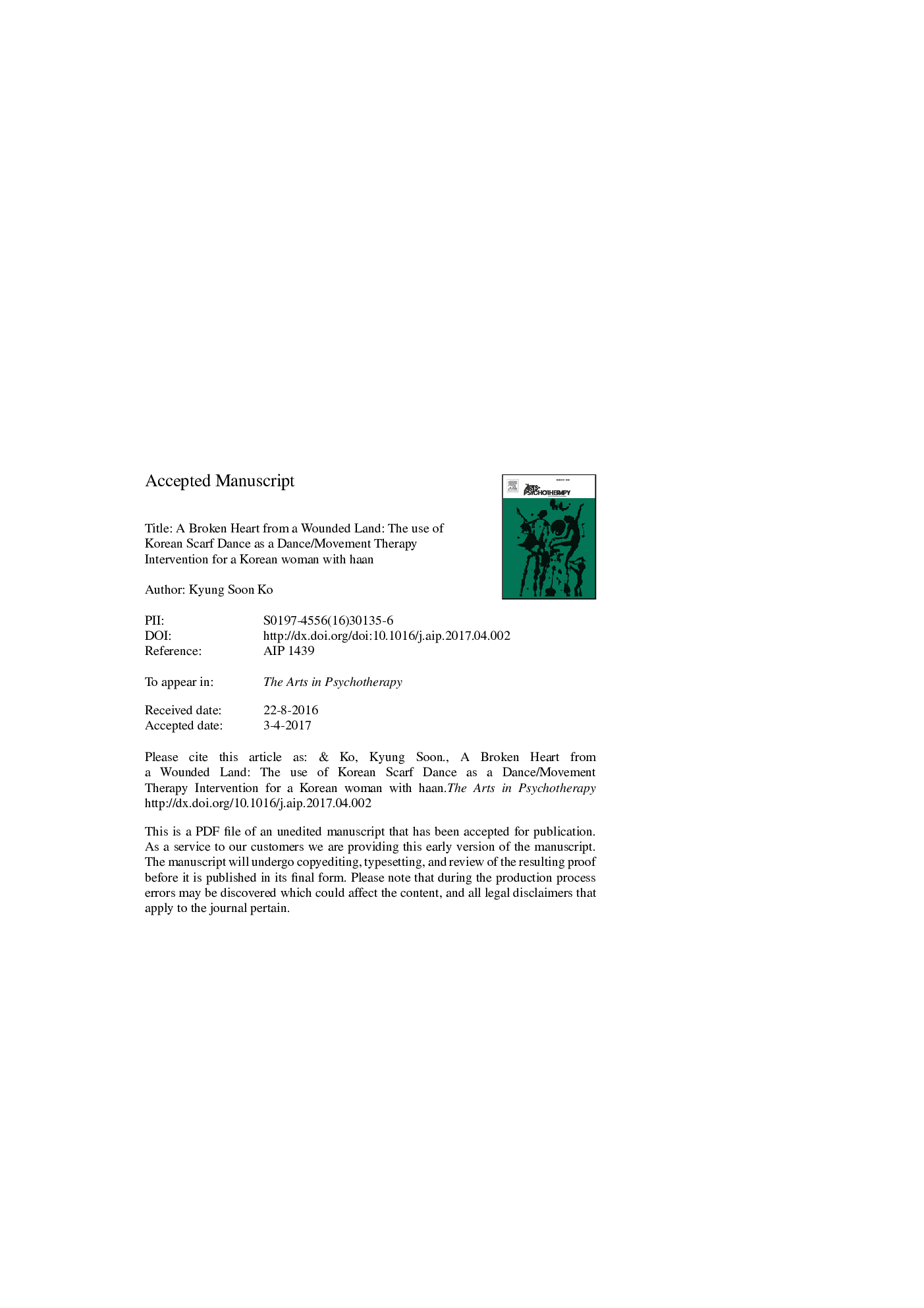| کد مقاله | کد نشریه | سال انتشار | مقاله انگلیسی | نسخه تمام متن |
|---|---|---|---|---|
| 4935684 | 1434297 | 2017 | 36 صفحه PDF | دانلود رایگان |
عنوان انگلیسی مقاله ISI
A broken heart from a wounded land: The use of Korean scarf dance as a dance/movement therapy intervention for a Korean woman with haan
ترجمه فارسی عنوان
یک قلب شکسته از زمین زخمی: استفاده از رقص شال کره ای به عنوان مداخله رقص / حرکت درمانی برای یک زن کره ای با هان
دانلود مقاله + سفارش ترجمه
دانلود مقاله ISI انگلیسی
رایگان برای ایرانیان
ترجمه چکیده
این مطالعه یک توصیف غنی و مفصل از مطالعه موردی بالینی یک زن کره ای مبتلا به هان (احساس سرخوردگی کره ای) را فراهم می کند، که درمانگر رقص / جنبش با استفاده از یک روسری کره ای در 10 جلسه تمرین می کند. دو سوال تحقیق خاصی مطرح شد: (الف) تجربه عاطفی مشتری در ایجاد رقص روسری خود چه بود؟ (ب) چه عناصری از حرکت بدن اغلب توسط مشتری در ایجاد رقص روسری خود استفاده می شود؟ داده ها از طریق یادداشت های گرفته شده پس از جلسات، یک اندازه گیری هماهنگ طراحی شده توسط محقق و نقشه های ساخته شده توسط مشتری جمع آوری شد. این داده ها چهار موضوع را ایجاد می کند: (الف) تمایل به حرکت به جلو؛ (ب) یک ظرف عاطفی گرم جوش؛ (ج) بدن در درد و شرم؛ و (د) عقل از هر دو بدن حرکت و سکوت. این چهار تم شامل 13 دسته و 59 کد است. تجربه ایجاد یک رقص روسری موجب شد تا اکتشافات عاطفی عمیق هان را تسهیل کند، که در آن، انعطاف پذیری و قدرت در بدن مشتری را باز کرد. استفاده از فضا یک عنصر برجسته در ایجاد این رقص روسری بود، زیرا حرکت به عقب و جلو به صورت نمادین خاطرات مشتری از سوء استفاده گذشته و تمایل او به حرکت به جلو بود.
موضوعات مرتبط
علوم پزشکی و سلامت
پزشکی و دندانپزشکی
روانپزشکی و بهداشت روانی
چکیده انگلیسی
This study provides a rich and detailed description of a clinical case study of a Korean woman suffering from haan (a Korea-specific feeling of oppression), which the dance/movement therapist treated using a Korean scarf dance over 10 sessions. Two specific research questions were addressed: (a) What was the client's emotional experience in creating her own scarf dance? (b) What elements of body movement were mostly utilized by the client in creating her own scarf dance? Data were gathered through notes taken after sessions, a researcher-designed haan-measurement, and drawings made by the client. These data produced four themes: (a) a desire to move forward, (b) a boiling hot emotional container, (c) a body in pain and shame, and (d) wisdom from both the moving and silent body. These four themes contained 13 categories and 59 codes. The experience of creating a scarf dance facilitated a deep emotional exploration of haan, which unlocked resilience and power within the client's body. The use of space was a prominent element in creating this scarf dance, as moving backwards and forwards symbolically represented the client's memories of past abuse and her desire to move forward, respectively.
ناشر
Database: Elsevier - ScienceDirect (ساینس دایرکت)
Journal: The Arts in Psychotherapy - Volume 55, September 2017, Pages 64-72
Journal: The Arts in Psychotherapy - Volume 55, September 2017, Pages 64-72
نویسندگان
Kyung Soon Ko,
